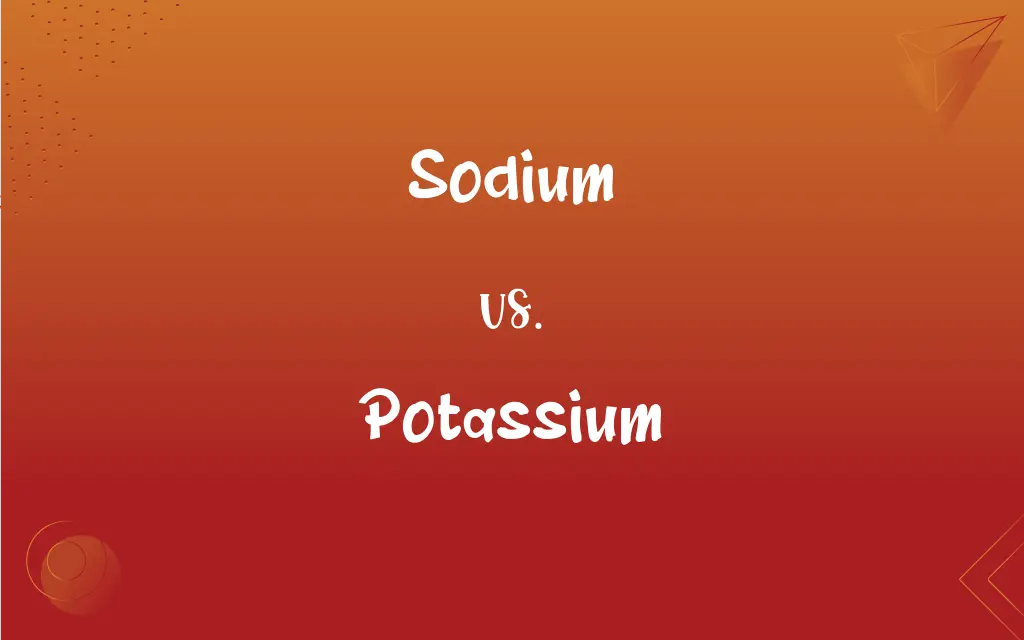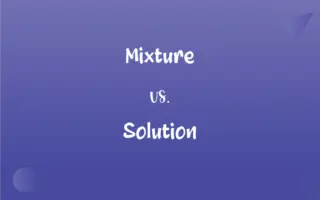Sodium vs. Potassium: What's the Difference?
Edited by Janet White || By Harlon Moss || Updated on October 25, 2023
Sodium and potassium are essential dietary minerals; sodium aids in fluid balance, while potassium helps muscle and nerve function.

Key Differences
Sodium and potassium are both alkali metals, found in the first column of the periodic table, but they have distinct differences in their properties and functions. Sodium, with the symbol Na, is a soft, silvery-white metal that is highly reactive with water. On the other hand, potassium, represented as K, is also a soft metal but has a lighter silvery hue compared to sodium.
In our diet, sodium is primarily known for its role in maintaining fluid balance and blood pressure regulation. High sodium intake is often linked with hypertension and other cardiovascular issues. Potassium, in contrast, is vital for muscle contraction, nerve function, and maintaining a regular heartbeat. A deficiency in potassium can lead to muscle weakness and irregular heart rhythms.
In the world of chemistry, sodium reacts violently with water, producing hydrogen gas and sodium hydroxide. Potassium's reaction with water is even more vigorous than sodium's, often igniting the released hydrogen. These reactions showcase the inherent reactivity of these metals.
In everyday life, many are familiar with sodium in the form of table salt, or sodium chloride. It's a staple in kitchens around the world. Potassium, meanwhile, is recognized in the context of foods like bananas, which are known for their high potassium content.
While sodium and potassium share similarities as alkali metals and essential dietary minerals, they have unique characteristics, functions, and roles in human health and chemistry, making them distinct from one another.
ADVERTISEMENT
Comparison Chart
Symbol
Na
K
Reaction with Water
Reacts violently, producing hydrogen gas and sodium hydroxide.
Reacts more vigorously than sodium, igniting released hydrogen.
Primary Dietary Role
Maintains fluid balance and blood pressure.
Supports muscle contraction, nerve function, and heart rhythm.
Common Source
Table salt (sodium chloride).
Bananas.
Atomic Number
11
19
ADVERTISEMENT
Sodium and Potassium Definitions
Sodium
An essential dietary mineral for fluid balance.
Dieticians often advise monitoring sodium intake to maintain health.
Potassium
Reacts vigorously with water.
Potassium's interaction with water resulted in a small flame.
Sodium
Represented by the symbol Na.
In the periodic table, sodium is denoted as Na.
Potassium
A light silvery alkali metal.
The metallic shimmer of potassium was evident in the sample.
Sodium
Commonly known in the form of table salt.
He sprinkled some sodium chloride onto his fries.
Potassium
Essential for muscle and nerve functions.
She ate a banana to boost her potassium levels before the marathon.
Sodium
A soft, silvery-white alkali metal.
She observed the shiny appearance of sodium under the microscope.
Potassium
Denoted by the symbol K.
In chemical equations, potassium is represented as K.
Sodium
Highly reactive with water.
The sodium sample produced gas when dropped into water.
Potassium
Renowned for its presence in bananas.
For a quick source of potassium, he grabbed a banana from the kitchen.
Sodium
A soft, light, extremely malleable silver-white element that is an alkali metal, reacts violently with water, is naturally abundant in combined forms, especially in common salt, and is used in the production of a wide variety of industrially important compounds. Sodium ions are essential to numerous biological processes in animals. Atomic number 11; atomic weight 22.9898; melting point 97.80°C; boiling point 883°C; specific gravity 0.971 (20°C); valence 1. See Periodic Table.
Potassium
A soft, silver-white, extremely reactive element that is an alkali metal, is essential to plant and animal cell functions, and occurs in nature only in compounds. It can be obtained by electrolysis of its hydroxide and is found in, or converted to, a wide variety of salts used especially in fertilizers and soaps. Atomic number 19; atomic weight 39.098; melting point 63.5°C; boiling point 759°C; specific gravity 0.86; valence 1. See Periodic Table.
FAQs
Can high sodium intake be harmful?
Yes, excessive sodium can lead to hypertension and cardiovascular issues.
What can result from a potassium deficiency?
Potassium deficiency can cause muscle weakness and irregular heart rhythms.
Is sodium chloride the same as table salt?
Yes, sodium chloride is the chemical name for table salt.
Which foods are rich in potassium?
Foods like bananas, spinach, and potatoes are high in potassium.
Are both sodium and potassium found in the periodic table?
Yes, both sodium (Na) and potassium (K) are elements in the periodic table.
Why is potassium important for muscle function?
Potassium is essential for muscle contraction and nerve impulse transmission.
What's the role of sodium in the body?
Sodium helps maintain fluid balance and regulates blood pressure.
Are sodium and potassium both alkali metals?
Yes, both sodium and potassium belong to the alkali metal group.
How are sodium and potassium used in industries?
Sodium is used in producing glass and soap, while potassium is used in fertilizers and soaps.
Can I get potassium from fruits other than bananas?
Yes, oranges, cantaloupes, and avocados are also good sources of potassium.
What's the atomic number of sodium and potassium?
Sodium's atomic number is 11, while potassium's is 19.
Which is lighter in color, sodium or potassium?
Potassium has a lighter silvery hue compared to sodium.
How does potassium benefit nerve function?
Potassium aids in transmitting nerve impulses throughout the body.
Are sodium and potassium found in nature?
Both sodium and potassium are naturally occurring, though they are often found in compounds rather than pure form.
Why are both sodium and potassium essential for health?
Sodium and potassium play crucial roles in fluid balance, muscle function, nerve transmission, and heart health.
Can I find sodium in foods other than salt?
Yes, sodium is also present in processed foods, cured meats, and some dairy products.
Which is more reactive with water, sodium or potassium?
Potassium reacts more vigorously with water than sodium.
Why shouldn't sodium be exposed to air?
Sodium can react with moisture in the air, making it hazardous.
How do sodium and potassium maintain heart health?
Sodium regulates blood pressure, and potassium ensures a regular heartbeat.
Are sodium and potassium metals?
Yes, both sodium and potassium are soft metals.
About Author
Written by
Harlon MossHarlon is a seasoned quality moderator and accomplished content writer for Difference Wiki. An alumnus of the prestigious University of California, he earned his degree in Computer Science. Leveraging his academic background, Harlon brings a meticulous and informed perspective to his work, ensuring content accuracy and excellence.
Edited by
Janet WhiteJanet White has been an esteemed writer and blogger for Difference Wiki. Holding a Master's degree in Science and Medical Journalism from the prestigious Boston University, she has consistently demonstrated her expertise and passion for her field. When she's not immersed in her work, Janet relishes her time exercising, delving into a good book, and cherishing moments with friends and family.































































